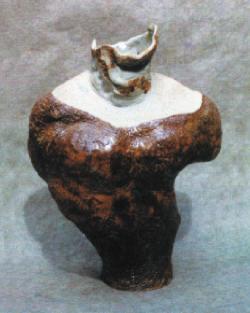Sojourn
at Ginza
Mustafa
Zaman
Halimul
Islam, a ceramic artist who has very recently been dabbling into
painting, has had a show of his art at Ginza, Tokyo, Japan. G.S.
Kabir has been the key operator who has been arranging exhibitions
of Bangladeshi artists in Japan for the last five years. The recent
one was of Halimul's ceramic and painting show at the Sudo Art
Museum.
“I have started
doing paintings since last October. I am new to this media and
I have tried to attain the textural configurations that I often
use in my ceramic works,” says Halimul, a thirty-plus artist who
so far had had two solo exhibitions in the home front. This was
the first occasion that he ventured out to create a buzz in the
outside world.

A
visitor at the show at Sudo Art Museum.
“The
first impression of Japan was of a negative one. I got annoyed
to see people behaving in a mechanistically rigid manner,” reveals
Halimul. The shock was about how they meticulously maintained
the civic rules, from crossing the roads to sitting for dinner
there were strict rules to be followed, which, “made me a bit
uncomfortable at first,” says Halimul who soon began to realise
the fruits of all these sacrifices.
Halimul went
to Japan on the occasion of his solo art show. He was fortunate
enough to attend another group show where several other recognised
Bangladeshi artists like G.S. Kabir, Iftikhar Uddin Ahmed, Selina
Choudhury and Salahuddin Ahmed participated. The event was of
a transnational kind, where twenty-five artists from five countries
participated. This annual event is titled CAF (Contemporary Art
Festival). The Modern Art Museum of Saitana played the host, and
the organiser was the Contemporary Artists' Club, of which there
are 254
registered members who are all artists.
“The struggle
the artists put up to survive is a universal phenomenon, perhaps
abroad they have a lot of facilities, yet in order to survive
there is a certain amount of struggle on the part of each artist,”
says Halimul, whose perception became clearer after mingling with
the artists who came from Europe. “In Japan survival results from
devotion and hard work. The positive thing about Japan is that
they have enough facilities provided both by the government and
the non-government sector. This certainly enables the artists
to work continuously and on a large scale,” Halimul contends.

A
stoneware by the artist.
Primarily
a ceramic artist, Halimul's painting has a very simplified, though
sometimes dour, look. Texture is often complimented by black forms
he places around the edges of his work to strike a compositional
balance. The black forms are the impressions of wood-blocks that
the artist buys from the market. “These blocks are applied with
much care, as their patterns must be consistent with what I have
achieved on the surface already by hand,” confirms Halimul. His
idea of painting is premised on abstraction, though in many of
his pottery suggestion of human torso is discernible. Though in
the final contour however the interplay between abstract form
and figure is obvious.
Ceramics in
Bangladesh saw a new turn in its course when Mohammad Fakhrul
Islam came up with structures that defied norms. The widespread
use of pot-like shapes or vases were sidestepped for the first
time by this young artist back in the early nineties. Halimul
too started out as an artist of human form, which marked him out
as a norm-defying ceramic artist. Though, in the next ten years
Halimul's oeuvre became flanked by two different tendencies of
expression -- one of the figure-like potteries and the other of
shell-like ones. The paintings by this young artist reside in
a thoroughly abstract ground; as such the expressions seem too
mellow for the viewers to respond spontaneously. This area remains
under-ploughed, though the artist testifies, “Many visitors who
came to the show really did like what they saw, they expressed
that it was something different from their previous encounters
with Bangladeshi paintings.” He also adds that it was his ceramic
that the Japanese spectators really fell in love with.
Ceramic cannot
survive without institutional support. The artist's quest to attain
his or her goal is thwarted when the physical resources are lacking.
The furnace and a studio are the most important of all elements.
In a country where the clay is good for this form of art, artists
like Halimul needs to have access to the studio facilities to
thrive.
The
solo show of Halimul Islam took off on 11 October and lasted till
the 16th of the same month. The show was sponsored and organised
by G.S. Kabir.


